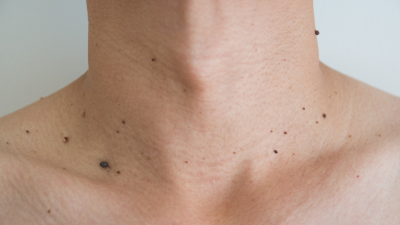Skin tags, also known as “acrochordons,” are essentially little pieces of skin that hang off of your body, usually around areas where your skin rubs against itself—your groin, your eyelids, your armpits, etc—essentially, wherever you have folds of skin. They can also be caused by skin rubbing against clothing.
They tend to be flesh or dark-colored and are typically between 2–5 centimeters large. They’re common and can appear on anyone, regardless of age or gender. However, they are particularly prevalent among middle-aged and overweight people.
They also don’t always have to appear where skin rubs together—it’s possible for skin tags anywhere on your skin except for your palms and the soles of your feet.
Though these growths aren’t dangerous (they’re tumors, but they’re not a form of cancer), they can be aesthetically displeasing or physically annoying. If they get caught on clothing or jewelry, they can be painful when pulled.
What Causes Skin Tags?
Beyond the theory that skin rubbing against skin or clothing causes skin tags, not much is actually known for sure.
It’s also possible that they’re caused by human papillomavirus (HPV), though the referenced study only found HPV (the most common sexually transmitted disease (STD)) in about 50% of people with skin tags and others believe skin tags are related to an increased toxic burden on the body.
Skin tags are found in about half the population, and they’re more common in people who are obese, people who have diabetes, and people who have a history of skin tags in their family, which suggests that there’s a genetic element to them.
Pregnant women also tend to have more skin tags due to hormonal changes that cause hyperactive growth in their skin cells. People with lots of loose skin, which can be caused by pregnancy or by previously being obese, also tend to develop skin tags more than average.
Fortunately, they are easily removed in a variety of ways.
Is It a Good Idea to Remove Skin Tags?
While unsightly, skin tags are generally considered harmless, which means it’s a personal decision as to whether to remove them or not.
Because removal is seen as a cosmetic procedure, insurance usually doesn’t cover it. However, if you develop a complication with your skin tags, that can change. Insurance may cover skin tag removal in the following situations, though individual insurance requirements will always vary:
- The skin tag has become heavily irritated or is bleeding regularly
- The skin tag is on your eyelid and is affecting your ability to see
- The skin tag is causing you pain, especially if it’s sudden, unexpected pain
In these cases, you’ll want to see a medical provider who specializes in skin tag removal. Skin tags can develop blood clots inside of them, which have the potential to enter your bloodstream and cause a stroke or heart attack.
They can also become malignant—remember, they are tumors—so if you have one that’s growing or changing, you’ll want to have it checked out right away.
How to Remove Skin Tags
Skin tags don’t necessarily have to be removed surgically, but that is an option. When we say “surgically,” we mean a simple in-office procedure that only requires a local anesthetic.
The reason it’s best to opt for such a procedure is that there are potential complications and problems inherent to at-home remedies.
One of the main potential problems is that you can get an infection. Going to a professional ensures that you have the best possible chance of avoiding infection.
Another reason to go to a professional medical care provider is that skin tags will be removed far more quickly through in-office procedures. Many at-home remedies can take days or even weeks to work. Some methods don’t work at all, which means you end up with a damaged skin tag that never gets removed.
Some people also use improper at-home treatments that damage their skin. For example, wart remover is far more powerful than what a skin tag requires. Using this at-home remedy on a skin tag can scar your skin permanently.
Some skin tags are also untreatable (or dangerous to treat) at home. If a skin tag is very large, you may not be able to remove it with an at-home remedy. Skin tags that are close to sensitive areas, like your genitals or your eyes, are potentially dangerous to remove yourself as the remedies may irritate or damage these sensitive areas.
Here are some of the ways that a medical care provider may remove your skin tags.
Cryotherapy
During cryotherapy, the skin tag is frozen with liquid nitrogen, causing it to fall right off. Though liquid nitrogen is usually used, some other substances can be used instead.
Freezing can cause a blister or scab, and it may take a while before the skin tag falls off. Your healthcare provider may freeze only part of the skin tag and then cut it off.
Surgery
Surgery is simple and involves a small amount of local anesthetic. They’ll then cut the skin tag off with a surgical blade or scissors. They’ll apply medication to stop the bleeding and put on a bandage. The procedure takes very little time.
Cauterization
Cauterization is not used as often as it used to be, but it’s still effective. The skin tag is burned off in one to two treatments. Many people prefer to avoid this method because a more advanced method that’s very similar has been developed—electrodesiccation.
Electrodesiccation
This method of removal for skin tags uses a tiny needle and a little bit of electricity to electrocute your skin tag, killing all the cells that make it up. Sometimes the skin tag is destroyed entirely. You’ll have a scab afterward, which may take several weeks to heal.
While there are many at-home remedies, we recommend working with a medical care provider to stay safe and get the best possible outcome.

